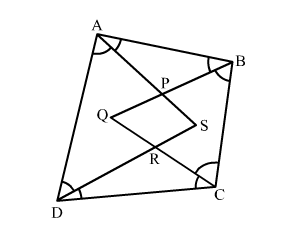If bisectors of ∠A and ∠B of a quadrilateral ABCD intersect each other at P, of ∠B and ∠C at Q, of ∠C and ∠D at R and of ∠D and ∠A at S then PQRS is a
(a) rectangle
(b) parallelogram
(c) rhombus
(d) quadrilateral whose opposite angles are supplementary

Given: In quadrilateral ABCD, AS, BQ, CQ and DS are angle bisectors of angles A, B, C and D, respectively.
∠QPS = ∠APB (Vertically opposite angles) ...(1)
In ΔAPB,
∠APB + ∠PAB + ∠ABP = 180° (Angle sum property of triangle.)
$\Rightarrow \angle A P B+\frac{1}{2} \angle A+\frac{1}{2} \angle B=180^{\circ}$
$\Rightarrow \angle A P B=180^{\circ}-\frac{1}{2}(\angle A+\angle B)$ ...(2)
From (1) and (2), we get
$\angle Q P S=180^{\circ}-\frac{1}{2}(\angle A+\angle B)$ ...(3)
Similarly, $\angle Q R S=180^{\circ}-\frac{1}{2}(\angle C+\angle D)$ ...(4)
From (3) and (4), we get
$\angle Q P S+\angle Q R S=360^{\circ}-\frac{1}{2}(\angle A+\angle B+\angle C+\angle D)$
$=360^{\circ}-\frac{1}{2}\left(360^{\circ}\right)$
$=360^{\circ}-180^{\circ}$
$=180^{\circ}$
So, PQRS is a quadrilateral whose opposite angles are supplementary.
Hence, the correct option is (d).
